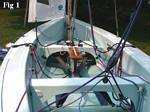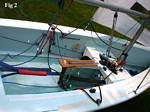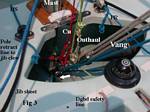 Fig #1, the whole boat from the back, serves for orientation.
Fig #1, the whole boat from the back, serves for orientation.
 Fig #1, the whole boat from the back, serves for orientation.
Fig #1, the whole boat from the back, serves for orientation.
 Fig. #2. The view from the driver's seat (minus the driver).
Fig. #2. The view from the driver's seat (minus the driver).
Starting top center with "A." A is the jib sheet. It goes from the block on the tank to a turning block by the leeward rail, then to a Harken cam cleat. This eliminates the cleated sheet crossing the boat and gives the crew MUCH more room. Ken Deyett (1st, 2002 Nationals) uses a variation on this system in which the line goes forward to the forward thwart, turns, and cleats. Both systems give up only about 2o of sheeting angle, and make crew movements much easier. We sheet inside the shrouds, which have been relocated as far outboard as allowed by Windmill rules.
B. is the port side of the double-ended 6:1 vang. Line cleats in a clam cleat located on the tank well below the deck. At the deck edge the line goes through a fairlead, keeping it always at hand, even when fully hiked.
C. is the port side of the double-ended 4:1 Cunningham, another part of which may be seen as #3, red line along the mast. Cleats next to vang, and in same set-up.
D. just below the daggerboard cap is the cleat for the outhaul (also seen coming down from the forward end of the boom's yellow line, #2).
E. is the wiskerpole launcher. The line comes down from the mast to a block (1) on the forward thwart. It then runs aft through a cleat on the thwart and through a small block on the end of a short line at E. Skipper or crew need only pull on the line through that block. From any angle the line cleats. This location prevents fouling with the jib sheets, and is much easier for the skipper, particularly when sailing alone. For pole launcher/retractor see The Jouster, Vol. 39.6, Nov-Dec. 1999, pg 4-6.
F. is the suction bailer.
G. is a short line attached to the boom at one end and to a heavy shackle at the other. The shackle holds the line close to the main sheet. This line, shown in use by Lightning’s in Sailing World magazine (Dec-Jan 2002, pg 43), is for gybing. It gives you something very solid by which to grab the boom in high wind and steep waves. Ethan and Larry use variations on this.
H. is the mainsheet. I have been using a headknocker, but am about to replace it with a ratchamatic block.
I. is the 1:1 traveler block position control on the Port side. Starboard side looks the same.
S. is an enlarged and elongated daggerboard cap which provides an excellent seat for the crew. From that position the crew can move fluently to leeward or windward. The board, even when raised, clears the crew (however, my crew always looks with suspicion at that sharp trailing edge!). Skipper moves somewhat forward to counterbalance weight. This was discussed in an issue of The Jouster (Vol. 40.1, Jan- Feb 2000, pgs 1 and 4).
 Fig. #3. Close up of the forward thwart. A large stainless steel
mast tang serves to close the mast gate. We block both fore and
aft. Aft to control mast bend and springiness of the rig, fore to
prevent pumping in chop. Cu is the Cunningham. PR on the Stb.
side is the pole launcher/retractor line on its way to its cleat.
The original part of my vang is gray line (3:1) to which I added a
2:1 double ended section (blue line). The green line at the arrow
is part of the 8:1 jib halyard cascade which cleats on the port
side of the daggerboard cap. A previous owner of my boat had
installed two fairlead/cam cleats, one on each side of the mast
opening. I have no idea what they were for. I am presently using
them to dead-end the crews hiking straps (HS). The fairlead on
the Stb. side also serves as attachment point for a block of the
pole launcher system.
Dgbd safety line is used to prevent loss of the daggerboard in the event of
a capsize. We just tie it to the hand-hold at the top of the board.
Fig. #3. Close up of the forward thwart. A large stainless steel
mast tang serves to close the mast gate. We block both fore and
aft. Aft to control mast bend and springiness of the rig, fore to
prevent pumping in chop. Cu is the Cunningham. PR on the Stb.
side is the pole launcher/retractor line on its way to its cleat.
The original part of my vang is gray line (3:1) to which I added a
2:1 double ended section (blue line). The green line at the arrow
is part of the 8:1 jib halyard cascade which cleats on the port
side of the daggerboard cap. A previous owner of my boat had
installed two fairlead/cam cleats, one on each side of the mast
opening. I have no idea what they were for. I am presently using
them to dead-end the crews hiking straps (HS). The fairlead on
the Stb. side also serves as attachment point for a block of the
pole launcher system.
Dgbd safety line is used to prevent loss of the daggerboard in the event of
a capsize. We just tie it to the hand-hold at the top of the board.
07/10/2002